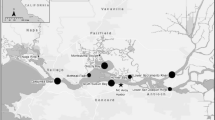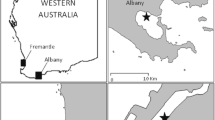Abstract
A 4.1 million m3 coal ash release into the Emory and Clinch rivers in December 2008 at the Tennessee Valley Authority’s Kingston Fossil Plant in east Tennessee, USA, prompted a long-term, large-scale biological monitoring effort to determine if there are chronic effects of this spill on resident biota. Because of the magnitude of the ash spill and the potential for exposure to coal ash-associated contaminants [e.g., selenium (Se), arsenic (As), and mercury (Hg)] which are bioaccumulative and may present human and ecological risks, an integrative, bioindicator approach was used. Three species of fish were monitored—bluegill (Lepomis macrochirus), redear sunfish (L. microlophus), and largemouth bass (Micropterus salmoides)—at ash-affected and reference sites annually for 5 years following the spill. On the same individual fish, contaminant burdens were measured in various tissues, blood chemistry parameters as metrics of fish health, and various condition and reproduction indices. A multivariate statistical approach was then used to evaluate relationships between contaminant bioaccumulation and fish metrics to assess the chronic, sub-lethal effects of exposure to the complex mixture of coal ash-associated contaminants at and around the ash spill site. This study suggests that while fish tissue concentrations of some ash-associated contaminants are elevated at the spill site, there was no consistent evidence of compromised fish health linked with the spill. Further, although relationships between elevated fillet burdens of ash-associated contaminants and some fish metrics were found, these relationships were not indicative of exposure to coal ash or spill sites. The present study adds to the weight of evidence from prior studies suggesting that fish populations have not incurred significant biological effects from spilled ash at this site: findings that are relevant to the current national discussions on the safe disposal of coal ash waste.




Similar content being viewed by others
References
Adams SM, Greeley MS (2000) Ecotoxicological indicators of water quality: using multi-response indicators to assess the health of aquatic ecosystems. Water Air Soil Pollut 123(1–4):103–115
Ankley GT, Bennett RS, Erickson RJ, Hoff DJ, Hornung MW, Johnson RD, Serrrano JA (2010) Adverse outcome pathways: a conceptual framework to support ecotoxicology research and risk assessment. Environ Toxicol Chem 29(3):730–741
Bartov G, Deonarine A, Johnson TM, Ruhl L, Vengosh A, Hsu-Kim H (2012) Environmental impacts of the Tennessee Valley Authority Kingston coal ash spill. 1. Source apportionment using mercury stable isotopes. Environ Sci Technol 47(4):2092–2099
Barwick M, Maher W (2003) Biotransference and biomagnification of selenium copper, cadmium, zinc, arsenic and lead in a temperate seagrass ecosystem from Lake Macquarie Estuary, NSW, Australia. Mar Environ Res 56(4):471–502
Beck ML, Hopkins WA, Hallagan JJ, Jackson BP, Hawley DM (2014) Exposure to residual concentrations of elements from a remediated coal fly ash spill does not adversely influence stress and immune responses of nestling tree swallows. Conserva Physiol. doi:10.1093/conphys/cou018
Bevelhimer MS, Adams SM, Fortner AM, Greeley MS, Brandt CC (2014) Using ordination and clustering techniques to assess multi-metric fish health response following a coal ash spill. Environ Toxicol Chem 33(8):1903–1913
Bryan AL Jr., Hopkins WA, Parikh JH, Jackson BP, Unrine JM (2012) Coal fly ash basins as an attractive nuisance to birds: parental provisioning exposes nestlings to harmful trace elements. Environ Pollut 161:170–177
Deonarine A, Bartov G, Johnson TM, Ruhl L, Vengosh A, Hsu-Kim H (2013) Environmental impacts of the Tennessee Valley Authority Kingston coal ash spill. 2. Effect of coal ash on methylmercury in historically contaminated river sediments. Environ Sci Technol 47(4):2100–2108
Etnier DA, Starnes WC (1994) Fishes of Tennessee. University of Tennessee Press, Knoxville, p 696
Gillespie RB, Baumann PC (1986) Effects of high tissue concentrations of selenium on reproduction by bluegills. Trans Am Fish Soc 115(2):208–213
Greeley MS Jr., Adams M, McCracken K (2012) Evaluating the effects of the Kingston fly ash release on fish reproduction: spring 2009–2010 Studies (No. ORNL/TM-2012/142). Oak Ridge National Laboratory (ORNL), Oak Ridge
Greeley MS Jr., Elmore LR, McCracken MK, Sherrard RM (2014) Effects of sediment containing coal ash from the kingston ash release on embryo-larval development in the Fathead minnow, Pimephales promelas (Rafinesque, 1820). Bull Environ Contam Toxicol 92(2):154–159
Hammerschmidt CR, Sandheinrich MB (2005) Maternal diet during oogenesis is the major source of methylmercury in fish embryos. Environ Sci Technol 39(10):3580–3584
Jacobasch C, Völker C, Giebner S, Völker J, Alsenz H, Potouridis T, Heidenreich H, Kayser G, Oehlmann J, Oetken M (2014) Long-term effects of nanoscaled titanium dioxide on the cladoceran Daphnia magna over six generations. Environ Pollut 186:180–186
King KA, Custer TW, Weaver DA (1994) Reproductive success of barn swallows nesting near a selenium-contaminated lake in east Texas. USA Environ Pollut 84(1):53–58
Lemly AD (1993) Teratogenic effects of selenium in natural populations of fresh water fish. Ecotoxicol Environ Saf 26(2):181–204
Lemly AD (2002) Symptoms and implications of selenium toxicity in fish: the Belews Lake case example. Aquat Toxicol 57:39–49
Lemly AD (2014) Teratogenic effects and monetary cost of selenium poisoning of fish in Lake Sutton, North Carolina. Ecotoxicol Environ Saf 104:160–167
Lemly AD, Skorupa JP (2013) Wildlife and the coal waste policy debate: proposed rules for coal waste disposal ignore lessons from 45 years of wildlife poisoning. Environ Sci Technol 46(16):8595–8600
Lohner TW, Reash RJ, Willet VE, Fletcher J (2001) Assessment of tolerant sunfish populations (Lepomis sp.) inhabiting selenium-laden coal ash effluents: 3. Serum chemistry and fish health indicators. Ecotoxicol Environ Saf 50(3):225–232
Mathews TJ, Fortner AM, Jett RT, Morris J, Gable J, Peterson MJ, Carriker N (2014) Selenium bioaccumulation in fish exposed to coal ash at the Tennessee Valley Authority Kingston spill site. Environ Toxicol Chem 33(10):2273–2279
Otter RR, Hayden M, Mathews T, Fortner A, Bailey FC (2013) The use of tetragnathid spiders as bioindicators of metal exposure at a coal ASH spill site. Environ Toxicol Chem 32(9):2065–2068
Peterson MJ, Southworth GR, Crumby WD (1996) Monitoring mercury in fish in a stream system receiving multiple industrial inputs. Environ Monit Assess 40(1):91–105
Pracheil BM, Hogan JD, Lyons J, McIntyre PB (2014) Using hard-part microchemistry to advance conservation and management of North American freshwater fishes. Fisheries 39(10):451–465
Rose KA (2000) Why are quantitative relationships between environmental quality and fish populations so elusive? Ecol Appl 10(2):367–385
Ruhl L, Vengosh A, Dwyer GS, Hsu-Kim H, Deonarine A, Bergin M, Kravchenko J (2009) Survey of the potential environmental and health impacts in the immediate aftermath of the coal ash spill in Kingston, Tennessee. Environ Sci Technol 43(16):6326–6333
Ruhl L, Vengosh A, Dwyer GS, Hsu-Kim H, Deonarine A (2010) Environmental impacts of the coal ash spill in Kingston, Tennessee: an 18-month survey. Environ Sci Technol 44(24):9272–9278
Sackett DK, Aday DD, Rice JA, Cope WG, Buchwalter D (2010) Does proximity to coal-fired power plants influence fish tissue mercury? Ecotoxicology 19(8):1601–1611
Southworth GR, Peterson MJ, Ryon MG (2000) Long-term increased bioaccumulation of mercury in largemouth bass follows reduction of waterborne selenium. Chemosphere 41(7):1101–1105
Souza MJ, Ramsay EC, Donnell RL (2013) Metal accumulation and health effects in raccoons (Procyon lotor) associated with coal fly ash exposure. Arch Environ Contam Toxicol 64(4):529–536
Stewart R, Grosell M, Buchwalter D, Fisher N, Luoma S, Mathews T, Orr P, Wang W (2010) Bioaccumulation and trophic transfer of selenium. SETAC Pellston workshop. CRC Press, pp 93–139
Tennessee Valley Authority (TVA) (2009) Continuing investigation of the nature and extent of ash in the Emory, Clinch and Tennessee River bottoms. Tennessee Valley Authority, Knoxville
Tsui MT, Wang WX (2005) Influences of maternal exposure on the tolerance and physiological performance of Daphnia magna under mercury stress. Environ Toxicol Chem 24(5):1228–1234
US Environmental Protection Agency (USEPA) (2012) Hazard Ranking System (HRS) Documentation Record for Clinch River Corporation, Atlanta. http://www.epa.gov/superfund/sites/docrec/pdoc1873.pdf. Accessed 1 Mar 2014
Völker C, Oetken M, Oehlmann J (2013) The biological effects and possible modes of action of nanosilver. In: Whitacre DM (ed) Reviews of environmental contamination and toxicology, vol 223. Springer, New York, pp 81–106
Acknowledgments
This research was sponsored by the Tennessee Valley Authority (TVA) and performed at Oak Ridge National Laboratory (ORNL). ORNL is managed by UT-Battelle, for the US Department of Energy under Contract DE-AC05-00OR22725. Accordingly, the United States Government retains and the publisher, by accepting the article for publication, acknowledges that the United States Government retains a non-exclusive, paid-up, irrevocable, world-wide license to publish or reproduce the published form of this manuscript, or allow others to do so, for United States Government purposes. Special thanks to C. Brandt, J. Smith, K. McCracken, C. Dunn, R. Vitale, K. Abbot, E. Rodgers, B. Rogers, M. Cagley, T. Baker, and N. Carriker.
Author information
Authors and Affiliations
Corresponding author
Ethics declarations
Conflict of interest
This study was funded by the Tennessee Valley Authority. All authors declare that they have no conflict of interest
Animal consent
All applicable international, national, and institutional guidelines for the care and use of animals were followed.
Additional information
S. Marshall Adams: Retired.
Electronic supplementary material
Below is the link to the electronic supplementary material.
Rights and permissions
About this article
Cite this article
Pracheil, B.M., Marshall Adams, S., Bevelhimer, M.S. et al. Relating fish health and reproductive metrics to contaminant bioaccumulation at the Tennessee Valley Authority Kingston coal ash spill site. Ecotoxicology 25, 1136–1149 (2016). https://doi.org/10.1007/s10646-016-1668-0
Accepted:
Published:
Issue Date:
DOI: https://doi.org/10.1007/s10646-016-1668-0




